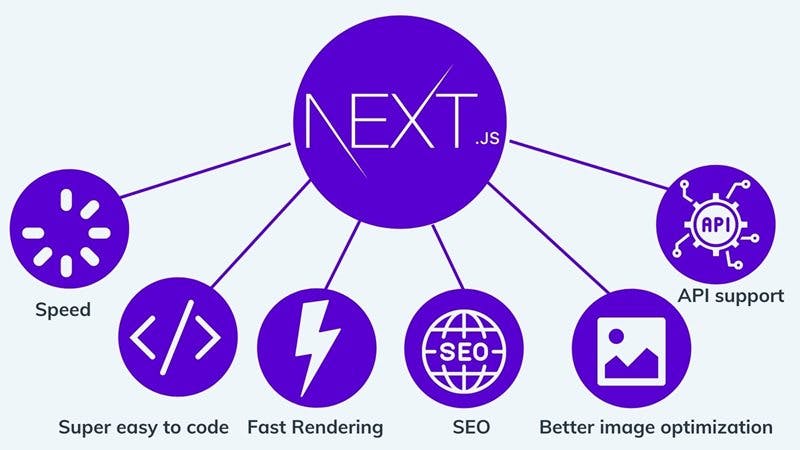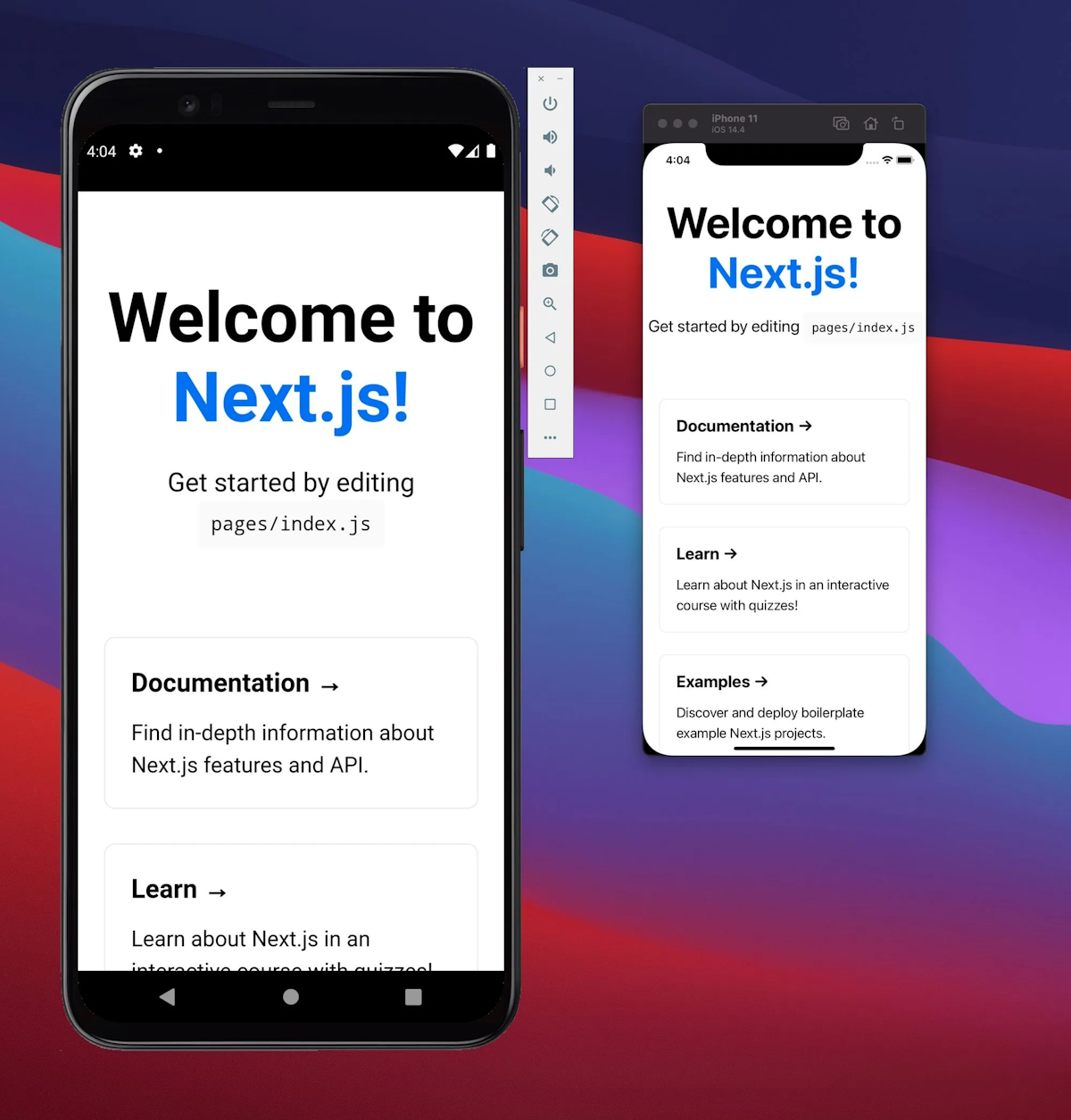
What is Next.js? A Comprehensive Guide
by Irina KedyarovaAugust 2nd, 2023
Summary
What is Next.js? How does it work?
What is Next.js used for?
Advantages of using Next.js
What does Next.js use for the backend?
Is Next.js good for apps?
Why is Next.js so popular?
FAQs
Scroll to read all the article.
What is Next.js? How does it work?
Next.js is a powerful and flexible React framework that simplifies the process of building server-rendered React applications. Developed by Vercel, Next.js has gained immense popularity due to its ability to enable server-side rendering and static site generation with ease. This framework provides an excellent developer experience and optimizes web applications for both performance and search engine optimization.
Next.js works as a layer on top of React, adding several features and optimizations that make building complex applications smoother. It seamlessly integrates with React applications, making the transition effortless for developers already familiar with React.
What is Next.js used for?
Next.js is used as a powerful and flexible framework for building web applications with React. It serves as a layer on top of React, providing several essential features and optimizations that streamline the development process and enhance the performance of web applications.
Here are some of the primary uses of Next.js:
Server-side Rendering (SSR):
Next.js allows developers to perform server-side rendering, where the initial rendering of the page happens on the server before being sent to the client. This feature is beneficial for applications that require fast-loading and SEO-friendly pages.
Static Site Generation (SSG):
Next.js supports static site generation, enabling the generation of HTML pages at build time. This approach is ideal for content-driven websites and blogs, as it eliminates the need for server-side processing and improves the website's performance.

Automatic Code Splitting:
Next.js automatically splits code into smaller chunks, loading only the necessary code for a specific page. This results in faster page loads and a smoother user experience.
Hot Module Replacement (HMR):
Next.js provides HMR, allowing developers to see the changes they make to the code in real-time without needing to refresh the entire page. This significantly speeds up the development process.
API Routes:
Next.js simplifies the creation of API endpoints within the application, making it easy to fetch data from external sources or perform server-side actions.
CSS and Styling:
Next.js offers built-in support for CSS modules and allows the use of Sass for styling, providing a convenient way to manage styles in projects.
Improved Performance:
With features like server-side rendering and automatic code splitting, Next.js significantly improves the performance of web applications, reducing the time it takes for pages to load.
SEO-Friendly:
Next.js ensures that web pages are easily crawlable and indexable by search engines, enhancing the website's visibility in search results.
Developer Experience:
Next.js offers an exceptional developer experience with features like hot module replacement and a straightforward project structure, making it easier for developers to build applications efficiently.
Overall, Next.js is a versatile and valuable tool for building modern web applications that prioritize performance, SEO, and developer productivity. Its capabilities make it a popular choice for various web development projects, from small-scale applications to large and complex websites.
Is Next.js used for frontend or backend?
Next.js is primarily used for frontend development. It is a frontend framework that is built on top of React, which is a popular JavaScript library for building user interfaces. Next.js enhances React by providing additional features like server-side rendering (SSR), static site generation (SSG), automatic code splitting, and more.
While Next.js can interact with backend services through API routes, it does not replace the need for a backend. Instead, it complements the backend by enabling seamless integration and enhancing the performance and user experience on the frontend.
In summary, Next.js is a frontend framework used to create user interfaces and optimize the rendering of web pages, while the backend is responsible for handling server-side logic, data storage, and other backend-related tasks. Together, they form a complete web application ecosystem.
Is Next.js for beginners?
Next.js is suitable for beginners. The framework is designed to be beginner-friendly, making it accessible to developers at all skill levels, including those who are just starting with web development.
Next.js provides a straightforward and well-documented development environment, which helps beginners get up and running quickly. The framework abstracts away many of the complexities of server-side rendering, routing, and other advanced features, allowing beginners to focus on building web applications without getting overwhelmed by technical intricacies.
Moreover, Next.js has an active and supportive community that provides ample learning resources, tutorials, and documentation. This makes it easier for beginners to find answers to their questions and seek guidance from experienced developers.
Whether you are new to web development or have some experience with frontend technologies, Next.js can be a great choice for learning and building web applications. Its simplicity and powerful features make it an excellent entry point for beginners in the world of modern web development.

Is Next.js a full stack framework?
Next.js is not a full-stack framework. Next.js is a frontend framework that focuses on enhancing the development of user interfaces for web applications. It is specifically built on top of React and provides additional features like server-side rendering (SSR) and static site generation (SSG).
While Next.js can interact with backend services through API routes, it does not replace the need for a backend server. Instead, it complements the backend by enabling seamless integration and enhancing the performance and user experience on the frontend.
A full-stack framework, on the other hand, would provide tools and capabilities for both frontend and backend development. It would encompass features for building user interfaces, handling server-side logic, managing databases, and more. Examples of full-stack frameworks include Django (Python), Ruby on Rails (Ruby), and Spring Boot (Java).
In summary, Next.js is a frontend framework that focuses on the client-side and the rendering of web pages, while the backend is responsible for handling server-side logic and data storage. As such, Next.js is best suited for building the frontend part of web applications, and developers often pair it with backend technologies to create full-fledged, full-stack web applications.
Advantages of using Next.js
Next.js offers several benefits that make it a popular choice for building web applications. Here are some of the key advantages of using Next.js:
Improved Performance:
Next.js provides server-side rendering (SSR) and automatic code splitting, which result in faster page loads and better performance. SSR pre-renders the pages on the server, reducing the time it takes for the initial page to load, and automatic code splitting ensures that only the necessary code is loaded for each page, optimizing the loading process.
SEO-Friendly:
With server-side rendering and static site generation (SSG), Next.js enables search engines to easily crawl and index the content of web pages. This enhances the website's visibility in search results and improves its overall SEO performance.
Developer Experience:
Next.js offers an excellent developer experience with features like hot module replacement (HMR) and a straightforward project structure. HMR allows developers to see changes in real-time without refreshing the entire page, speeding up the development process and improving productivity.
Built-in File-based Routing:
Next.js simplifies the creation of pages by organizing them in a "pages" directory. This file-based routing system automatically sets up routes for the application, making it easier to manage and navigate between different pages.
API Routes:
Next.js makes it effortless to create API endpoints within the application. These endpoints can be used to fetch data from external sources or perform server-side actions, providing a seamless way to interact with backend services.
Middleware Support:
Next.js supports middleware, allowing developers to modify the request and response objects before they reach the page's rendering. This offers flexibility and customization options in handling incoming requests.
CSS and Styling Support:
Next.js comes with built-in support for CSS modules, allowing developers to scope CSS locally to avoid conflicts. It also enables the use of Sass for styling, making it convenient to manage styles in projects.
Serverless Deployment:
Next.js applications can be easily deployed on serverless platforms like Vercel. This allows for cost-effective scaling and reduces the need for managing infrastructure.
Community and Ecosystem:
Next.js has a vibrant and active community that continuously contributes to its development. It has a rich ecosystem of plugins, extensions, and libraries, making it easier for developers to add additional functionality to their projects.
In summary, Next.js offers significant benefits, including improved performance, SEO-friendliness, a great developer experience, and a robust ecosystem. Its features make it a compelling choice for building modern web applications that prioritize speed, user experience, and search engine visibility.

What does Next.js use for the backend?
Next.js itself is a frontend framework and does not include a built-in backend. Instead, Next.js is agnostic to the backend technology used and can work seamlessly with various backend solutions.
For the backend, developers have the freedom to choose from a wide range of options, depending on their preferences and project requirements. Some common choices for the backend with Next.js include:
Node.js with Express:
Node.js is a popular backend runtime that allows developers to build server-side applications using JavaScript. When combined with Express.js, a minimal and flexible web application framework for Node.js, developers can create powerful backend APIs to handle data processing, authentication, and other server-side operations.
Serverless Functions:
Next.js can be deployed on serverless platforms like Vercel, which allows developers to use serverless functions as a backend. Serverless functions are small, single-purpose functions that are executed in response to HTTP requests. They can be used to handle API endpoints and other backend functionalities.
Databases and Data Storage:
Next.js applications can interact with databases like MongoDB, MySQL, PostgreSQL, or others for data storage and retrieval. The choice of database depends on the project's specific needs, such as data structure, scalability, and performance requirements.
RESTful APIs:
Next.js can consume data from external APIs, which are typically built and hosted on separate backend servers. RESTful APIs allow Next.js applications to fetch data from third-party services or interact with other systems.
GraphQL APIs:
Next.js can also work with GraphQL APIs, which offer a more flexible and efficient way to request and manipulate data. GraphQL provides a single endpoint for querying data, allowing clients to request precisely the data they need, reducing over-fetching and under-fetching.
Other Backend Technologies:
Next.js is versatile and can be integrated with other backend technologies like Ruby on Rails, Django, Firebase, or any other backend framework that provides API endpoints or data services.
In summary, Next.js is designed to be agnostic to the backend technology used, allowing developers to choose the backend solution that best fits their project requirements. This flexibility makes Next.js a powerful choice for building web applications with a wide range of backend options.
Is Next.js good for apps?

Next.js is excellent for building web applications, including both traditional websites and modern web apps. Its powerful features and benefits make it a popular and versatile choice for various types of applications. Here's why Next.js is well-suited for building apps:
Performance Optimization:
Next.js provides server-side rendering (SSR) and automatic code splitting, leading to improved performance and faster page loads. This is particularly advantageous for web apps where users expect a smooth and responsive experience.
SEO-Friendly:
With SSR and static site generation (SSG) capabilities, Next.js ensures that web apps are search engine optimized. This means search engines can easily crawl and index the content, resulting in better visibility in search results.
Developer Productivity:
Next.js offers a fantastic developer experience with features like hot module replacement (HMR), file-based routing, and a straightforward project structure. This makes development faster and more efficient, benefiting app development workflows.
API Routes:
Next.js allows developers to create API endpoints within the application, making it seamless to interact with backend services and external APIs. This is crucial for app functionality that requires data fetching and integration with external systems.
Dynamic Data Handling:
With Next.js, developers can handle dynamic data and real-time updates efficiently. Features like server-side rendering and automatic code splitting ensure that the app remains responsive and up-to-date.
Styling and CSS Support:
Next.js supports CSS modules and Sass for styling, which makes it easier to manage styles in larger apps and maintain a consistent look and feel.
Scalability:
Next.js applications can be deployed on serverless platforms like Vercel, allowing for effortless scalability based on the app's demand. This ensures that the app can handle increased traffic without requiring additional infrastructure management.
Rich Ecosystem:
Next.js benefits from a robust ecosystem with a vibrant community that contributes to its growth. This ecosystem offers a wide range of plugins, extensions, and libraries that can enhance the functionality and features of web apps.
In conclusion, Next.js is an excellent choice for building web apps due to its performance optimizations, SEO-friendliness, developer productivity, dynamic data handling, and scalability. Its flexibility and powerful features make it well-suited for a wide range of applications, from small-scale projects to complex and feature-rich web apps.
Why is Next.js so popular?
Next.js has gained significant popularity for several compelling reasons, making it a widely adopted framework in the web development community:
Ease of Use:
Next.js offers a simple and intuitive API, making it accessible to developers of all skill levels. Its file-based routing system and well-structured project setup contribute to a smooth and straightforward development experience.
Performance Optimization:
Next.js provides server-side rendering (SSR) and automatic code splitting, resulting in faster initial page loads and improved performance. This performance boost is crucial for delivering a seamless user experience, which has contributed to its popularity.

SEO-Friendly:
Next.js supports server-side rendering and static site generation (SSG), making it inherently SEO-friendly. Search engines can easily crawl and index the pre-rendered content, leading to better search engine rankings and improved visibility.
Versatility:
Next.js can be used to build a wide variety of web applications, from simple static websites to complex and dynamic web apps. Its ability to handle various types of projects has made it a preferred choice for developers across different industries.
Excellent Developer Experience:
Next.js offers features like hot module replacement (HMR) and fast refresh, allowing developers to see changes in real-time without full-page reloads. This enhances the development process, saving time and improving productivity.
Strong Community and Support:
Next.js has a vibrant and active community that actively contributes to its development. The community provides extensive documentation, tutorials, and support, making it easier for developers to learn and use the framework effectively.
Scalability:
With support for serverless deployment on platforms like Vercel, Next.js enables easy scalability for web applications. This scalability is crucial for handling varying levels of traffic and ensures a smooth user experience even under heavy loads.
Integration with React:
Next.js is built on top of React, which is one of the most popular JavaScript libraries for building user interfaces. Its seamless integration with React allows developers to leverage the power of both technologies effectively.
Time-to-Market Advantage:
Next.js significantly reduces development time with features like pre-rendering and built-in routing. This allows developers to focus on building core functionalities and delivering products to the market faster.
Continuous Improvement:
The Next.js team and community are dedicated to continuous improvement and regularly release updates and new features. This commitment to innovation keeps the framework up-to-date with the latest web development trends.
In summary, Next.js' popularity can be attributed to its ease of use, performance optimization, SEO-friendliness, versatility, developer experience, strong community support, scalability, seamless integration with React, time-to-market advantage, and commitment to continuous improvement. All of these factors combined make Next.js a preferred choice for web developers looking to build modern, high-performing web applications.
Best Frequently Asked Questions (FAQs)
Next.js is a powerful and versatile framework that brings several benefits to the world of React development. With its robust features, including server-side rendering, static site generation, and automatic code splitting, it empowers developers to build high-performance and SEO-friendly web applications. By streamlining the development process and enhancing the developer experience, Next.js is undoubtedly the future of web development.
Comments
The flexibility of Next.js allows us to build both simple static websites and complex web applications. It's a versatile framework that fits our various project needs.
Michael P.
Leave your comment
Your feedback is very important to us. Share your thoughts on what you read, or tell your own story.
Rating